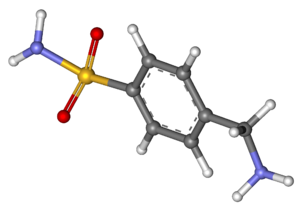Mafenide
 | |
 | |
| Names | |
|---|---|
| Trade names | Sulfamylon |
| Other names | Mafenide acetate |
| |
| Clinical data | |
| Drug class | Sulfonamide[1] |
| Main uses | Treat and prevent infections in people with burns[2] |
| Side effects | Pain, allergic reactions, acidosis[2] |
| Routes of use | Topical |
| External links | |
| AHFS/Drugs.com | Monograph |
| Legal | |
| Legal status |
|
| Chemical and physical data | |
| Formula | C7H10N2O2S |
| Molar mass | 186.23 g·mol−1 |
| 3D model (JSmol) | |
| |
| |
Mafenide, sold under the brand name Sulfamylon among others, is an antibiotic used to treat and prevent infections in people with burns.[2] Specifically it may be used for 2nd or 3rd degree burns.[1] It is applied to the skin as a cream or solution.[2]
Common side effects include pain at the site it was applied.[2] Other side effects may include allergic reactions and acidosis.[2] It should not be used in people with kidney problems.[3] It is a sulfonamide and is able to get through the eschar.[1][4]
Mafenide was discovered in the 1930s and came into medical use in the 1960.[3] It is available as a generic medication. In the United States 5 packs cost about 45 USD as of 2021.[5] It is also available in Japan.[6]
Medical uses
Mafenide is used to treat severe burns.[7][8] It is used topically as an adjunctive therapy for second- and third-degree burns. It is bacteriostatic against many gram-positive and gram-negative organisms, including Pseudomonas aeruginosa. Some sources state that mafenide is more appropriate for non-facial burns, while chloramphenicol/prednisolone or bacitracin are more appropriate for facial burns.[9]
Dosage
For use as adjunctive therapy for second- and third-degree burns to prevent infection, adults and children should apply topically to a thickness of approximately 1.6 mm to cleaned and debrided wound once or twice per day with a sterile gloved hand. The burned area should be covered with cream at all times.
Side effects
Side effects can include superinfection, pain or burning upon application, rash, pruritus, tachypnea, or hyperventilation. Mafenide is metabolized to a carbonic anhydrase inhibitor, which could potentially result in metabolic acidosis.
Interactions
There are no significant interactions.
Contraindications
Mafenide is contraindicated in those with sulfonamide hypersensitivity or renal impairment.
Mechanism of action
Mafenide works by reducing the bacterial population present in the avascular tissues of burns and permits spontaneous healing of deep partial-thickness burns.
References
- ↑ 1.0 1.1 1.2 Rosenthal, Laura; Burchum, Jacqueline (17 February 2017). Lehne's Pharmacotherapeutics for Advanced Practice Providers - E-Book. Elsevier Health Sciences. p. 822. ISBN 978-0-323-44779-9. Archived from the original on 14 November 2021. Retrieved 14 November 2021.
- ↑ 2.0 2.1 2.2 2.3 2.4 2.5 "Mafenide Monograph for Professionals". Drugs.com. Archived from the original on 27 January 2021. Retrieved 14 November 2021.
- ↑ 3.0 3.1 Wilson, William C.; Grande, Christopher M.; Hoyt, David B. (5 February 2007). Trauma: Resuscitation, Perioperative Management, and Critical Care. CRC Press. p. 944. ISBN 978-1-4200-1526-3. Archived from the original on 14 November 2021. Retrieved 14 November 2021.
- ↑ Cancio, Leopoldo C. (1 February 2021). "Topical Antimicrobial Agents for Burn Wound Care: History and Current Status". Surgical Infections. 22 (1): 3–11. doi:10.1089/sur.2020.368.
- ↑ "Mafenide Prices and Mafenide Coupons - GoodRx". GoodRx. Retrieved 14 November 2021.
- ↑ "Sulfonamides - Infectious Diseases". Merck Manuals Professional Edition. Archived from the original on 30 October 2021. Retrieved 14 November 2021.
- ↑ Siuda J. F.; Cihonski C. D. (1972). "New compounds: carbamate derivatives of mafenide (homosulfanilamide)". J. Pharm. Sci. 61 (11): 1856–1857. doi:10.1002/jps.2600611143. PMID 4652670.
- ↑ Haynes B. (1971). "Mafenide acetate in Burn Treatment". New England Journal of Medicine. 284 (23): 1324. doi:10.1056/NEJM197106102842310. PMID 5576444.
- ↑ Haik J, Ashkenazy O, Sinai S, et al. (November 2005). "Burn care standards in Israel: lack of consensus". Burns. 31 (7): 845–9. doi:10.1016/j.burns.2005.04.012. PMID 15967581.
External links
| Identifiers: |
|
|---|
- Pages using duplicate arguments in template calls
- Drugs with non-standard legal status
- Chemical articles with unknown parameter in Infobox drug
- Chemical articles without CAS registry number
- Articles without EBI source
- Chemical pages without ChemSpiderID
- Chemical pages without DrugBank identifier
- Articles without KEGG source
- Articles without UNII source
- Drugs missing an ATC code
- Drugboxes which contain changes to verified fields
- Drugboxes which contain changes to watched fields
- Articles with changed CASNo identifier
- Carbonic anhydrase inhibitors
- Sulfonamide antibiotics
- RTT